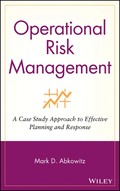 For several years now Mark Abkowitz’s book “Operational Risk Management” has been sitting on my “to-read” shelf. Given my recent wish for a case study approach to leadership and given the Fukushima nuclear issues, the book caught my attention.
For several years now Mark Abkowitz’s book “Operational Risk Management” has been sitting on my “to-read” shelf. Given my recent wish for a case study approach to leadership and given the Fukushima nuclear issues, the book caught my attention.
Books that analyse disasters are far superior to watching real-time disasters because the distress is minimised, the analysis can be dispassionate and time can provide a more detailed context. (The quickness of production of some of the books about the BP/Gulf of Mexico suffered from the curse of topicality) Books provide a distance that the constant exposure to “disaster porn” does not.
Operational Risk Management looks at many at many disasters from the last 30 years but the disasters are not only industrial and process disasters, although Chernobyl and Bhopal are covered. Continue reading “Operational Risk Management – a timeless book, sadly”

